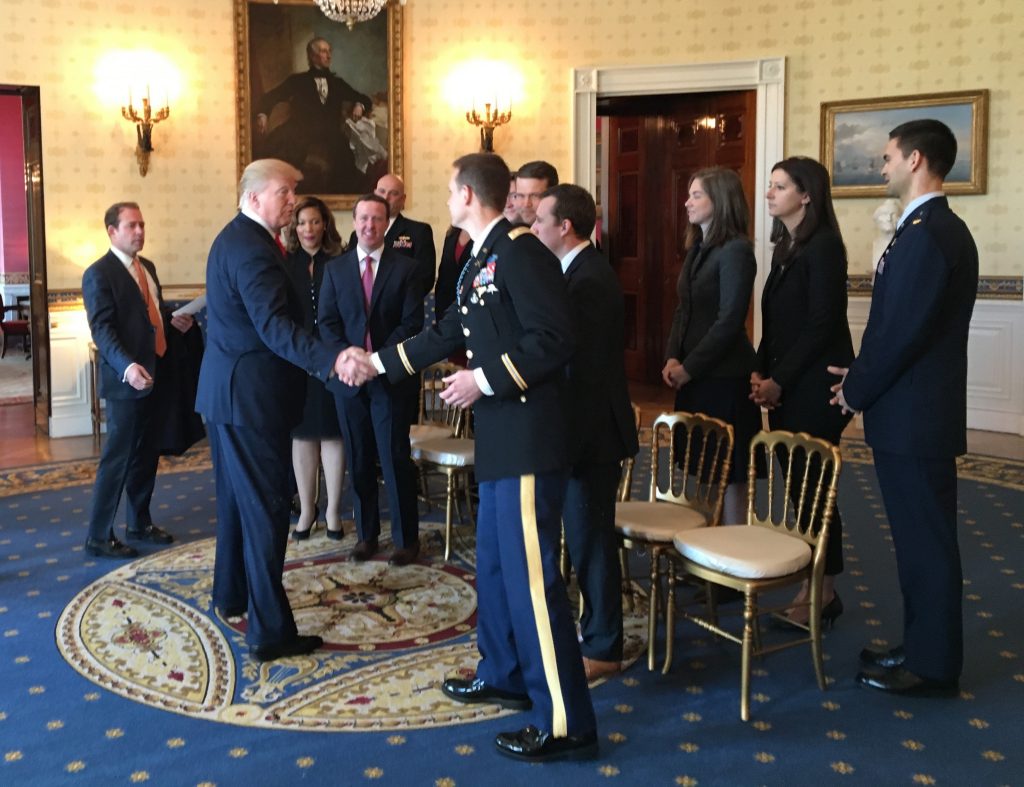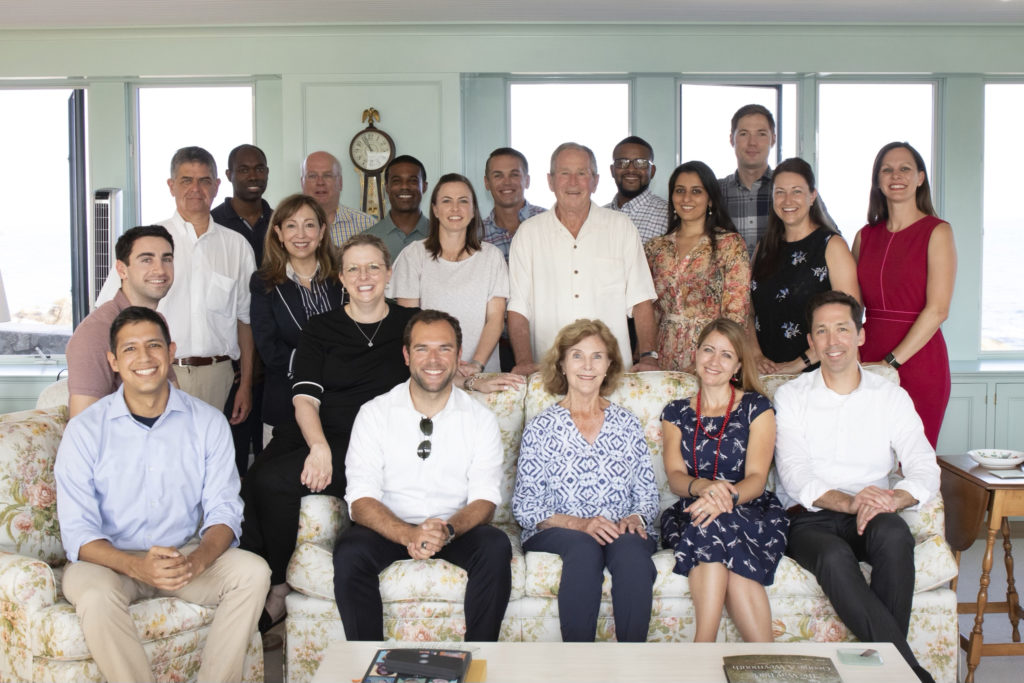What is the White House Fellowship?
Founded in 1964 by Lyndon B. Johnson, the White House Fellows program is one of America’s most prestigious programs for leadership and public service. White House Fellowships offer exceptional young men and women first-hand experience working at the highest levels of the federal government.
Selected individuals typically spend a year working as a full-time, paid Fellow to senior White House Staff, Cabinet Secretaries and other top-ranking government officials. Fellows also participate in an Education Program consisting of roundtable discussions with leaders from the private and public sectors. In some years, Fellows may also have the opportunity to study U.S. policy in action domestically, and potentially internationally. Fellowships are awarded on a strictly non-partisan basis.
The purpose of the White House Fellows program is to provide gifted and highly motivated young Americans with first-hand experience in the process of governing the Nation and a sense of personal involvement and responsibility in the leadership of society.


Work Placements
Engagement in the work of the federal government lies at the heart of a White House Fellowship. Work assignments offer the Fellows unparalleled experience working with senior administration officials on ever changing issues and challenges.
White House Fellows spend a year as full-time, paid assistants to senior White House Staff, the Vice President, Cabinet Secretaries and other top-ranking government officials. Their assignments demand a capacity for quick learning and a willingness to work hard, often on issues outside of their area of expertise. Responsibilities range from participating in interagency meetings and designing and implementing federal policies, to drafting speeches for cabinet secretaries to representing their agencies on Capitol Hill and in international treaty negotiations. The majority of time, effort, and learning experienced by each Fellow occurs as part of their work placement.


Education Program
In addition to their Work Placement, Fellows also participate in an Education Program during the Fellowship year. The Fellowship’s Education Program augments and enhances the work placement. It includes weekly speaker seminars in which each Fellows class meets with dozens of individuals including Supreme Court Justices, Cabinet Secretaries, senior White House officials, Members of Congress, military leaders, journalists, historians, business executives, leaders from non-government organizations, and foreign heads of state. These sessions generally take place during the week, and are off-the-record, lively and frank.
In some years, Fellows may also have the opportunity to study U.S. policy in action on domestic policy trips, and potentially on an international policy trip. The Education Program serves as an important aspect of the Fellowship experience, and increases the Fellows’ exposure to renowned leaders from the private and public sectors.


The President’s Commission on White House Fellowships
The President’s Commission selects the White House Fellows each year, and administers all aspects of the Fellowship work placements and educational program for those selected as Fellows. The President’s Commission includes: 1) the Commissioners who select the Fellows, and 2) the staff of the Commission office who run the program. Each Presidential administration appoints the individuals who serve as Commissioners and Commission staff. The Commissioners, led by the Chair and Vice Chair, interview the National Finalists each year, and recommend those individuals they find most qualified for the fellowship to the President for appointment as White House Fellows.
The Commission awards Fellowships on a strict non-partisan basis, and encourages balance and diversity in all aspects of the program.
The Director of the President’s Commission on White House Fellowships leads the full-time Commission staff who administer all elements of the White House Fellowship for the “current class”, including: determining work placements for each fellow, administering the Education Program and speaker series for the current class, coordinating domestic and/or international travel, leading the recruiting effort for prospective applicants for the next year’s class, evaluating applications, leading the regional interview process, etc.

The White House Fellows Foundation
The White House Fellows Foundation and Association is the alumni association comprised of all those who have served as White House Fellows since the program’s founding in 1964. The White House Fellows Foundation and Association, established in 1969, is a 501(c)(3) organization whose mission is to support:
- Those who have previously served as White House Fellows through our alumni activities, conferences, travel, and other support
- Those who are currently serving as White House Fellows through an annual Education Grant and other support to the President’s Commission
- Those who will serve as White House Fellows in the future through our efforts each year to recruit highly qualified candidates to the program

The History of the Founding of the White House Fellows Program
“Freedom and responsibility, liberty and duty. That’s the deal.” John Gardner, in one short phrase, captured the essence of the White House Fellows Program, the nation’s most prestigious leadership program.
Executive Order 11183 established the White House Fellows Program on October 3, 1964. The idea behind the White House Fellowship Program was not new. Indeed, in 1957, John Gardner, then President of the Carnegie Corporation, was concerned that the increasing complexity of the federal government had made it “some kind of strange monster, beyond our comprehension and beyond our sympathies.” He put his thoughts in a memo hoping to persuade other foundations to join him in starting a program to identify and expose young men and women of “intelligence, character, special talents, and promise” to the nation’s government,” believing that such a program would create “a reservoir of able men and women with more than ordinary comprehension of government and more than ordinary willingness to serve.” Most importantly, Gardner believed that the national consciousness they acquired in Washington would increase their value as citizens and community leaders.
Gardner’s idea did not spur any other foundation leaders to action, and he put the memo in a file, where it sat until the summer of 1964, which was marked by the growth of Youth for Goldwater organizations on college campuses across the country. Within a week after the republican convention ended, Gardner dusted off his memo and sent it to the President’s special consultant, historian Eric Goldman, outlining a “National Service Plan,” for President Johnson’s consideration. Gardner suggested that a small organization be formed to select “one hundred of the ablest and most highly motivated young men and women in the nation for a 15-month period of service with the government.” Selection would be based on “intelligence, character, special talents and general promise, and the standards would be so high that this would be as impressive an honor as a young person could win.” Each person selected would be given a meaningful work assignment that matched the candidate’s current work or education.
In addition to the educational value of the work, these young people would be brought together for weekly seminars that exposed them to “the big picture” issues of governing and they would attend a ten-day retreat in the middle of the year to discuss leadership principles.
Simultaneously, William C. Friday, the president of the University of North Carolina, sent the President a letter outlining his concerns about the student Goldwater movements on campuses, suggesting that President Johnson reach out to student leaders with an invitation to the White House.
On September 15, 1964, Goldman sent a memo to the President outlining Friday’s concerns noting that “a sizeable part of this [student] population does not feel as great a sense of rapport with the Administration as do other age groups” and that the most “practical way to get at the younger group is through college leaders.” Goldman closed his proposal for inviting student leaders to the White House by noting that no other president had ever summoned such an assortment of college leaders before and attached an abbreviated version of John Gardner’s updated memo with the notation that Gardner might be persuaded to fund a three-year pilot of the program through the Carnegie Foundation (which, in fact, provided $305,000 in 1964 to initially fund the program).
President Johnson’s response was immediate, with an enthusiastic go-ahead and extensive notations on the proposal both by him and Lady Bird. These notations included elevating the work assignments from the agencies as suggested by Gardner to the highest reaches of government. The number of Fellows would be reduced to 15 – one for each of ten cabinet officers, one for the vice-president, and four in the Office of the President. The First Lady suggested the name “White House Fellows” – and so it was chosen.
To get things rolling, the program would be established by Executive Order and announced at a special event for student leaders that was to be held, at the President’s request, on October 3, 1964, a mere two weeks away. Standing before 250 college leaders in the White House, the president announced that the White House Fellows Program that would bring 15 outstanding leaders each year to Washington for “first hand, high level experience in the workings of government.” Noting that citizen involvement was vital to freedom, President Johnson emphasized that “a genuinely free society cannot be a spectator society….Freedom in its deepest sense, requires participation – full, knowledgeable participation….A hundred years from now, when historians look back on this administration, I hope very much they will be able to say: There, once again, was an era when the young men and women of America and their government belonged to each other – belonged to each other in fact and in spirit.”
President Johnson wanted his White House Fellows to be selected by a highly esteemed and bipartisan committee. David Rockefeller was selected as Chairman, noting at the time that “I haven’t often been asked by Presidents to do things. I guess I felt that his request was a command, and so I agreed to serve as the first chairman of what would become the White House Fellows Commission.” Rockefeller was joined by NYT editor John Oakes, Stanford Business School Dean Earnest C. Arbuckle, Senator Margaret Chase Smith, U.S. Education Commission Francis Keppel, UNC President William Friday, University of Texas Chancellor Harry Ransom, University of Minnesota President O. Meredith Wilson, U.S. Circuit Court Justice William Hastie, union president James Carey, Civil Service Commission Chair John Macy, and John Gardner. Tom Carr, Director of the Civil Service Commission’s government executive development programs, was soon detailed to make Executive Order 11183 a reality.
Led by Chairman David Rockefeller, the selection committee soon defined a mission statement that posed both questions and this challenge:
“In this country today, we produce a great number of skilled professionals. But too few of this intellectual elite provide the society with statesmanlike leadership and guidance in public affairs. If the sparsely settled American colonies of the late 18th century could produce Washington, Jefferson, Adams, Monroe, Madison, Hamilton, Franklin, and others of superlative talent, breadth and statesmanship, should we not be able to produce in this generation ten times that number? We are not doing so.
Surely the raw material is still there. And just as surely more must be done in the development of our ablest young people to inspire and facilitate the emergence of such leaders and statesmen. Their horizons and experience must be broadened to give them a sense of personal involvement in the leadership of society, a vision of greatness for the society, and a sense of responsibility for bringing that greatness to reality.”
After negotiating an extremely rigorous application and selection process modeled on the Rhodes Scholarship Program, the first class of 15 White House Fellows was chosen in June and reported to Washington in September of 1965. Since then, more than 800 superbly qualified young Americans have served ten presidents as White House Fellows. After their Fellowship year, they have become leaders in every segment of our society.
